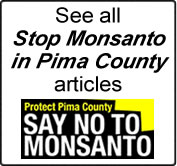Say “NO” to GMOs in the Gluten-Free Diet
by Melissa Diane Smith
How to avoid genetically modified organisms when you also avoid gluten.
When Marcia Popp, a 50-year-old graphic artist, began a nutrition coaching program with me last year, she had numerous health problems, including multiple food and environmental allergies. She also had been diagnosed in 1990 with a systemic immune condition known as eosinophilia-myalgia syndrome (EMS), which she developed after taking tryptophan supplements that were later found to be tainted.
Marcia had already cut gluten out of her diet nine years earlier, so I advised some different dietary changes to cater to her other food intolerances. I knew that genetically modified organisms (GMOs) were implicated in allergies – and that the tryptophan that was linked to EMS had been produced using genetically modified bacteria – so I also recommended that she avoid the eight major genetically modified (GM) foods to see if it made a difference in her condition.
I’m happy to report it really did. Her allergies have improved so much that her seasonal allergies are mostly gone now. Working with her allergist, Marcia was able to stop all of the allergy medications she took except for one she uses just occasionally. Her asthma has improved so much that her lung function tests were 98 percent the last time they were tested — the highest they have ever been. And certain immune cell counts regularly tested to monitor her EMS condition are now in the normal ranges for the first time in almost twenty years.
“Eliminating the GMOs has made the most impact for me,” Marcia says. “The results have been amazing.”
A Hidden Reason for More Allergies?
The incidence of allergies and asthma has dramatically increased in the past 20 years. During that same time, novel proteins from GMOs have been introduced into the food supply. Coincidence? Many experts don’t think so.
During the genetic modification process, unintended consequences, such as new unexpected allergens or higher levels of known allergens, can occur in the plant, increasing the likelihood of the development of allergies. Cooked GM soy, for example, contains seven times more trypsin inhibitor, a known soy allergen, than cooked non-GM soy. For these reasons, the American Academy of Environmental Medicine and the AllergyKids Foundation recommend avoiding GMOs to protect against allergies.
If you eat gluten free and would like to avoid GMOs, try these tips.
- Buy gluten-free food products that have the USDA Organic seal. The seal means that no genetically modified ingredients or derivatives were used in the manufacture of the product. An example: Go Raw sprouted seeds, flax crackers, and cookies by Freeland Foods are USDA Organic and also have been Gluten-Free Certified by the Gluten Free Certification Organization (GFCO).
- Look for gluten-free packaged foods that are Non-GMO Project Verified. Most processed foods contain GMOs. However, packaged foods labeled with a Non-GMO Project Verified seal are third-party verified to have been produced according to the best rigorous practices for GMO avoidance. Gluten-free foods that have been Non-GMO Project Verified include Edward & Sons Brown Rice Snaps, Organic Sunshine Burgers, Lundberg Family Farms rices and rice pastas, Lotus Foods heirloom rices, and Nutiva organic coconut, hemp seeds, flax seed, and chia seed products. Mary’s Gone Crackers Sticks & Twigs and Crackers and R.W. Garcia tortilla chips are both Gluten-Free Certified by GFCO and Non-GMO Project Verified. To download a Non-GMO Shopping Guide, go to www.nongmoshoppingguide.com.
- Avoid conventional forms of at-risk ingredients. Watch out for non-organic corn, soy, canola oil, cottonseed oil, and sugar derived from sugar beets. (Most foods that contain “sugar” in their ingredients contain a mixture of sugar from sugar cane and GM beet sugar.) Either steer clear of foods with these ingredients or purchase food products that have the Non-GMO Project Verified seal or organic forms of these ingredients. In the produce department, avoid papaya from Hawaii, conventional zucchini, yellow crookneck squash, and corn on the cob, all of which may be genetically modified.
- When eating out, order food cooked in olive oil. Stay away from foods made with vegetable oil, which almost always means soybean, corn, canola, or cottonseed oils, common sources of GMOs.
Want more tips to help you eat non-GMO? Join the Eat GMO Free Challenge, presented by the GMO Free Project of Tucson, which has a tip each day during the month of October – tips that I wrote and helped organize.
Copyright © 2011 Melissa Diane Smith

[…] a portion of an article by Melissa Diane Smith that appeared on the site AgainstTheGrainNutrition.com… Say “NO” to GMOs in the Gluten-Free […]